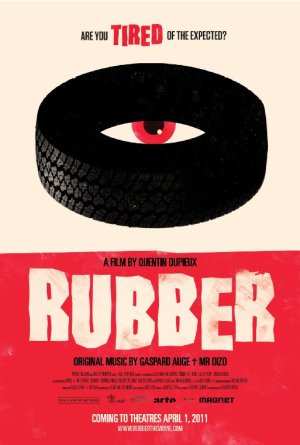B-Movies have always relied on simple set-ups, often so simple they’re summed up by the title itself. Earth vs. Flying Saucers, The Fly, Night of the Living Dead and so on. More ridiculous single-title premises include The Wasp Woman, The Killer Shrews, and over time these bizarre creations lead to self-aware stupidity such as Attack of the Killer Tomatoes in 1978 and countless buzzword combinations throughout the 1980’s, often “Cannibal” or “Zombie” followed by gruesome or apocalyptic word. Fast forward to 2010 and Rubber is released, threatening to trump even Killer Tomatoes for a single-mindedly ridiculous concept – a movie about a killer tyre. Selling itself as a straight-up B-Movie, it’s very soon evident however that this is something else; instilling various arthouse-y ideas into the plot results in an even stranger movie than the concept suggests.

This is the main character – it’s a tyre that kills people…
Opening with a long take of a car slowly knocking down chairs placed irregularly on a road, a police officer climbs out of the boot of the car to deliver a long monologue directly to camera about the following film having “no reason”, much like many other films that have “no reason”, such as E.T.: “Why is E.T. brown instead of green? No reason”. Odd attempts at humour sneak in; “Why does J.F.K. end in the sudden assassination of the president? No reason.”. They aren’t particularly funny, but add to a bizarre, hypnotic feeling that this film has where nothing is anywhere near as clever as it seems to think it is. The reveal of an in-movie “audience” watching Robert from afar as he discovers his ability to make small animals & people’s heads explode is another layer of this incredibly frustrating yet oddly compelling self-awareness running throughout the film. Sequences later on in the movie push the self-reference even further but I realised after the first half an hour or so that I’d all but submitted to the dreamlike surreality of it.

It’s a film about a killer tyre…
Shot on a Canon DSLR with a slim budget of around $500,000, this film looks a great deal better than you might expect. Great use of the desert landcapes gives a desolate, slow-paced feel, even though the film never drags. At least 80% of the effects for Robert (the name given to the tyre in the credits) are obviously someone just out of shot making it move in a lifelike manner or the cameraman giving it a little nudge to keep on rolling along, but the remaining shots depict Robert some impossible to replicate actions in wide shots that really make you pay attention. Never resorting to CGI, these shots are achieved with a brilliant remote control gimmick that director Quentin Dupieux likens to a hamster wheel. Nonetheless, whether you’re happy about it or not is irrelevant; the result is it really does seem like this tyre is alive. The action is far from non-stop as may have been expected prior to watching the movie, but when Robert does get murderous the practical effects are wonderfully gruesome, so we’re not entirely denied the B-Movie nonsense that was promised, and aside from the fourth-wall-breaking winks and nudges, the moments of more conventional humour are actually pretty funny.

Seriously, it’s about a tyre. Called Robert.
This is actually my second time watching Rubber, and it’s only after this second viewing that I read some interviews with Quentin Dupieux. Where I had expected him to claim some sort of hidden higher purpose to the film; some sort of commentary on film-making, audiences in general, or perhaps even something as pretentious as “the nature of reality”, the matter-of-fact and humorous insight into his method of writing the movie where he simply put in things he thought might be funny or interested him brings it all back to the opening scene’s monologue: there is truly “no reason” to any of it. It’s not a film for everyone; people attracted by the “Killer Tyre” concept expecting a stupid gore-fest will certainly be scratching their heads after a short while. Even knowing there isn’t a hidden subtext there remains a sense of pretention about it – perhaps even unintentional – but as a hypnotic, incomprehensible, and downright odd take on a B-Movie this serves as a fascinating curio as long as you manage to let yourself… roll with it… ugh.
6/10


 One of the 72 films labeled as a ‘Video Nasty’ in the someone-think-of-the-children hysteria of the 1980’s, Possession was not available uncut in the UK until 1999. The notoriety that comes with the ‘Video Nasty’ label suggests a film will be gratuitously excessive in sex and/or violence and, as is the case with many of them, rather thin on plot. This film is an exception to the second rule at least, directed by the Polish Arthouse director Andrzej Żuławski it is an allegorical, largely character-driven, and often incomprehensible take on the splatter-horror of the 70’s and 80’s.
One of the 72 films labeled as a ‘Video Nasty’ in the someone-think-of-the-children hysteria of the 1980’s, Possession was not available uncut in the UK until 1999. The notoriety that comes with the ‘Video Nasty’ label suggests a film will be gratuitously excessive in sex and/or violence and, as is the case with many of them, rather thin on plot. This film is an exception to the second rule at least, directed by the Polish Arthouse director Andrzej Żuławski it is an allegorical, largely character-driven, and often incomprehensible take on the splatter-horror of the 70’s and 80’s.

